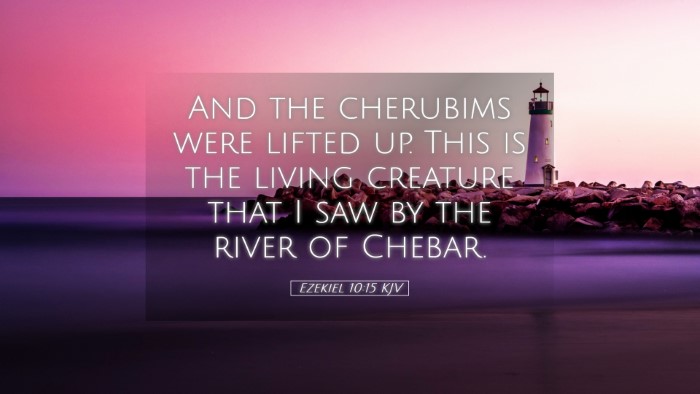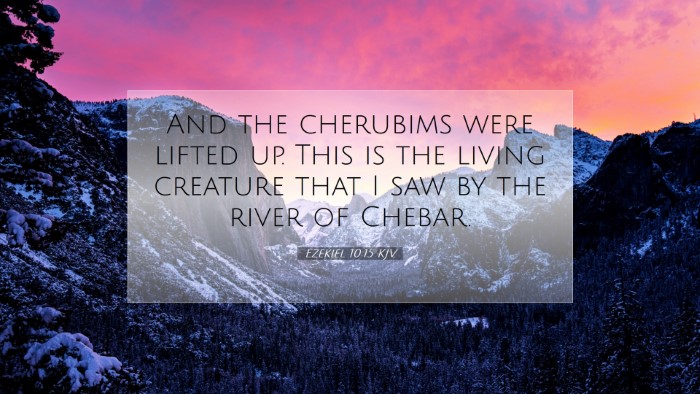Ezekiel 10:15 – Commentary and Insights
Bible Verse: "And the cherubims were lifted up. This is the living creature that I saw by the river of Chebar."
Introduction
The vision of the cherubim in Ezekiel 10:15 is rich with theological significance and reflects both the majesty of God and the complex nature of divine interactions with humanity. This commentary synthesizes insights from respected public domain sources, providing an in-depth understanding for pastors, students, theologians, and Bible scholars.
The Vision of the Cherubim
Ezekiel’s depiction of the cherubim emphasizes their role as guardians and mediators in God’s heavenly court. In the context of ancient Israel, cherubim were seen as symbolic representations of God's presence and majesty. Matthew Henry highlights that the lifting up of the cherubim signifies their readiness to execute God’s judgment and to move into action based on God's command.
Symbolism of the Cherubim
- Divine Presence: The cherubim are often viewed as a manifestation of God's glory. Adam Clarke notes that they are living beings that reflect the active and dynamic nature of God's presence in Israel.
- Guardianship: In biblical theology, cherubim are tasked with guarding sacred spaces, as seen in Genesis 3:24. This role is reiterated in Ezekiel, suggesting that God's holiness must be protected from sinfulness.
- Messengers of Judgment: Albert Barnes remarks that the movement of the cherubim can be interpreted as a sign of impending judgment on Jerusalem for its idolatry and disobedience.
The Context of Ezekiel's Prophecy
Understanding Ezekiel 10:15 requires a grasp of the historical and cultural backdrop. Ezekiel prophesied during the Babylonian exile, a time of significant turmoil for Israel. His visions serve to reassure the exiles of God's continued sovereignty and presence, even in their displacement.
Henry emphasizes the importance of these visions in reminding God's people that despite their circumstances, they have not been abandoned. The movement of the cherubim signifies God's active involvement in their lives, even amidst judgment.
Theological Reflections
The Nature of God’s Glory
The mention of cherubim in this passage raises significant theological questions about the nature of God's glory and its relationship to humanity. The glory of God, represented by the cherubim, is not distant but intimately involved in the affairs of the world. This involvement illustrates God’s both transcendence and immanence.
Clarke discusses how the glory of God, often depicted in the Old Testament as residing in the Holy of Holies, is here shown to have left the temple as a sign of judgment against Israel's unfaithfulness. This underscores a critical theme in Ezekiel's message: the need for God’s people to return to holiness.
The Cherubim as Living Creatures
The description of the cherubim as "living creatures" connects to the broader theme of life in the Spirit. The Hebrew word used for "creatures" indicates vitality and energy, suggesting that the cherubim are active participants in God’s will. This point is significant for understanding the holistic nature of worship and obedience to God.
Barnes points out that the cherubim's movement reflects the active engagement of the divine with the world, challenging the notion of a static deity. The dynamic nature of these beings serves as a reminder that worship requires action, not just passive observance.
Applications for Today
The insights drawn from Ezekiel 10:15 are pertinent for contemporary believers and leaders in the church. Understanding the role of the cherubim encourages a deep reflection on the nature of divine interaction in our lives.
Call to Holiness
One of the primary applications emerging from this passage is the call to holiness. Just as Israel was called to acknowledge God’s glory and reign, believers today are challenged to live in a manner worthy of that calling. This theme of holiness is echoed in 1 Peter 1:16, where believers are called to be holy as God is holy.
Awareness of God’s Presence
Moreover, the imagery of the cherubim serves as a reminder of God’s omnipresence and active participation in human affairs. As pastors and ministers, fostering an awareness of God’s presence among congregants can inspire a deeper engagement in worship and community life. Clarke's exposition on God's nearness encourages believers to seek God earnestly, knowing that He is actively involved in their lives.
Divine Judgment and Mercy
Finally, the dual themes of judgment and mercy encapsulated in this vision offer valuable insights into God’s character. While God does exercise judgment, He also desires restoration and reconciliation. This understanding can shape preaching and pastoral care, emphasizing both the seriousness of sin and the hope found in repentance and grace.
Conclusion
In conclusion, Ezekiel 10:15 offers profound insights into the nature of God’s presence, the role of divine beings, and the call to holiness for God’s people. The rich tapestry of symbolism and theology found in this passage challenges us to engage with God actively and to reflect His glory in our lives. As we study these insights from traditional commentaries, we are equipped to guide others in understanding the depth of God's Word and its applications for our lives today.


